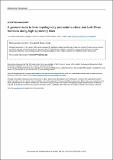Files in this item
A general route to form topologically-protected surface and bulk Dirac fermions along high-symmetry lines
Item metadata
| dc.contributor.author | Clark, Oliver Jon | |
| dc.contributor.author | Mazzola, Federico | |
| dc.contributor.author | Markovic, Igor | |
| dc.contributor.author | Riley, Jonathon Mark | |
| dc.contributor.author | Feng, Jiagui | |
| dc.contributor.author | Yang, B.-J. | |
| dc.contributor.author | Sumida, K. | |
| dc.contributor.author | Okuda, T. | |
| dc.contributor.author | Fujii, J. | |
| dc.contributor.author | Vobornik, I. | |
| dc.contributor.author | Kim, T. K. | |
| dc.contributor.author | Okawa, K. | |
| dc.contributor.author | Sasagawa, T. | |
| dc.contributor.author | Bahramy, M. S. | |
| dc.contributor.author | King , Phil | |
| dc.date.accessioned | 2020-03-11T00:34:01Z | |
| dc.date.available | 2020-03-11T00:34:01Z | |
| dc.date.issued | 2019-03-11 | |
| dc.identifier | 257950288 | |
| dc.identifier | b5af25cd-94ef-4428-bd27-3f2a8a285e4b | |
| dc.identifier | 000604915700003 | |
| dc.identifier | 85076336449 | |
| dc.identifier.citation | Clark , O J , Mazzola , F , Markovic , I , Riley , J M , Feng , J , Yang , B-J , Sumida , K , Okuda , T , Fujii , J , Vobornik , I , Kim , T K , Okawa , K , Sasagawa , T , Bahramy , M S & King , P 2019 , ' A general route to form topologically-protected surface and bulk Dirac fermions along high-symmetry lines ' , Electronic Structure , vol. 1 , no. 1 , 014002 . https://doi.org/10.1088/2516-1075/ab09b7 | en |
| dc.identifier.issn | 2516-1075 | |
| dc.identifier.other | ORCID: /0000-0002-1631-9556/work/64698117 | |
| dc.identifier.uri | https://hdl.handle.net/10023/19634 | |
| dc.description | Funding: EPSRC PhD studentship support through grant No. EP/K503162/1 (OJC); PhD studentship support from the IM-PRS for the Chemistry and Physics of Quantum Materials (IM). | en |
| dc.description.abstract | The band inversions that generate the topologically non-trivial band gaps of topological insulators and the isolated Dirac touching points of three-dimensional Dirac semimetals generally arise from the crossings of electronic states derived from different orbital manifolds. Recently, the concept of single orbital-manifold band inversions occurring along high-symmetry lines have been demonstrated, stabilising multiple bulk and surface Dirac fermions. Here, we discuss the underlying ingredients necessary to achieve such phases, and discuss their existence within the family of transition-metal dichalcogenides. We show how their three-dimensional band structures naturally produce only small kz; projected band gaps, and demonstrate how these play a significant role in shaping the surface electronic structure of these materials. We demonstrate, through spin- and angle-resolved photoemission and density functional theory calculations, how the surface electronic structures of the group-X TMDs PtSe2 and PdTe2 are host to up to five distinct surface states, each with complex band dispersions and spin textures. Finally, we discuss how the origin of several recently-realised instances of topological phenomena in systems outside of the TMDs, including the iron-based superconductors, can be understood as a consequence of the same underlying mechanism driving kz-mediated band inversions in the TMDs. | |
| dc.format.extent | 13 | |
| dc.format.extent | 16264075 | |
| dc.language.iso | eng | |
| dc.relation.ispartof | Electronic Structure | en |
| dc.subject | Dirac semimetals | en |
| dc.subject | Topological insulators | en |
| dc.subject | Spin-resolved ARPES | en |
| dc.subject | Transition metal dichalcogenides (TMDs) | en |
| dc.subject | QC Physics | en |
| dc.subject | TK Electrical engineering. Electronics Nuclear engineering | en |
| dc.subject | DAS | en |
| dc.subject.lcc | QC | en |
| dc.subject.lcc | TK | en |
| dc.title | A general route to form topologically-protected surface and bulk Dirac fermions along high-symmetry lines | en |
| dc.type | Journal article | en |
| dc.contributor.institution | University of St Andrews. Centre for Designer Quantum Materials | en |
| dc.contributor.institution | University of St Andrews. School of Physics and Astronomy | en |
| dc.contributor.institution | University of St Andrews. Condensed Matter Physics | en |
| dc.identifier.doi | 10.1088/2516-1075/ab09b7 | |
| dc.description.status | Peer reviewed | en |
| dc.date.embargoedUntil | 2020-03-11 |
This item appears in the following Collection(s)
Items in the St Andrews Research Repository are protected by copyright, with all rights reserved, unless otherwise indicated.

